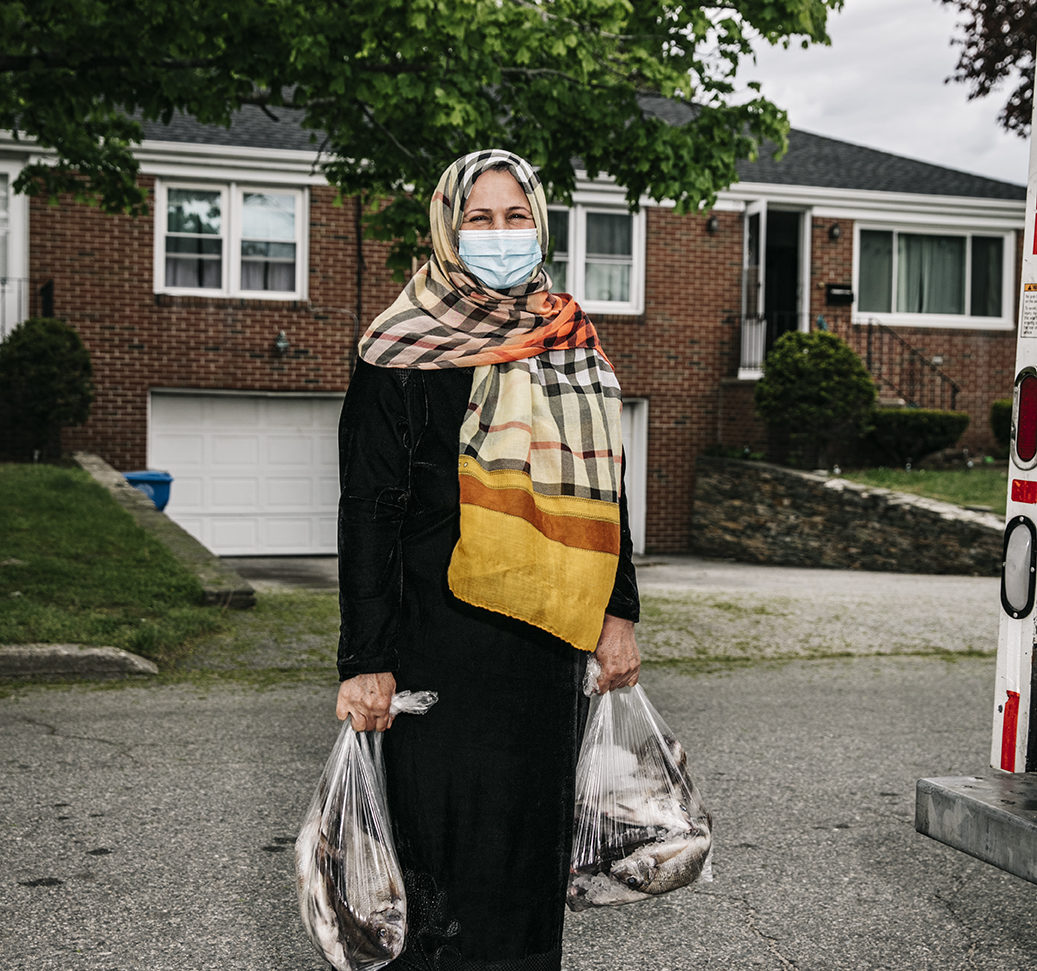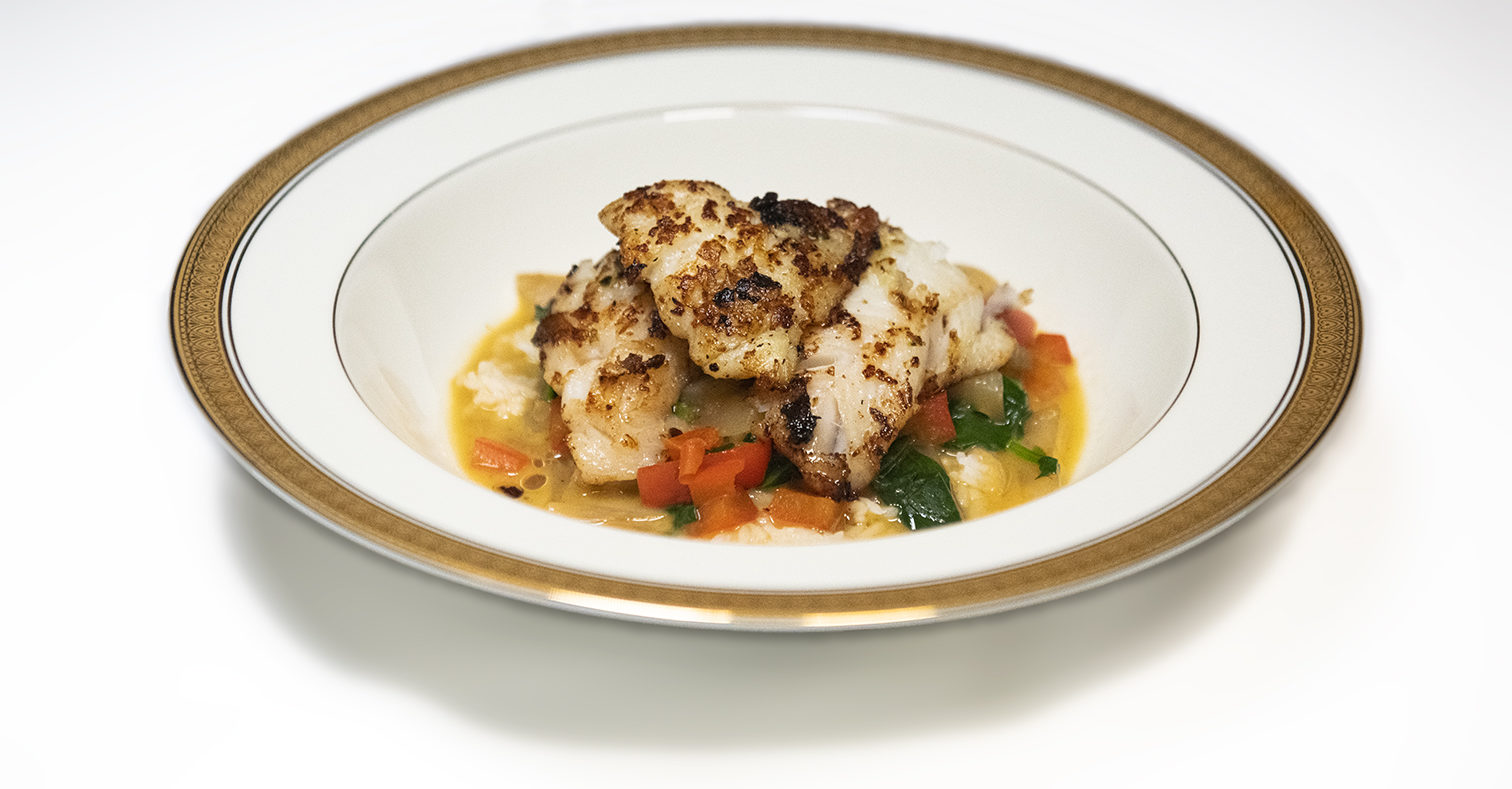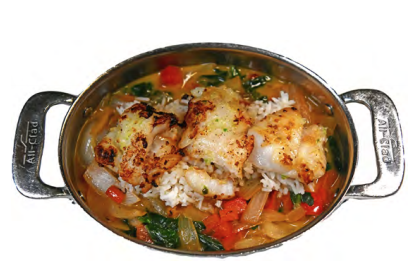Solidarity Through Seafood
Local Fishermen Help Those in Need - And Vice Versa
By Kate Masury | Photographs by Jesse Burke | Alice Howard portrait by Dana Smith“As fishermen, we harvest fish to feed people. It’s what we are good at, and now more than ever, as we navigate through the unprecedented pandemic, many Rhode Island families are in need of food,” says Fred Mattera, executive director of the Commercial Fisheries Center of Rhode Island (CFCRI).
One in four Rhode Island families were food insecure in 2020, according to a report by the Rhode Island Community Food Bank, and immigrant communities, people of color, and low-income families were disproportionately affected. Meanwhile, the commercial fishing industry was also experiencing unique challenges as a result of COVID-19. The closure or reduced flow in many of the supply chains that local seafood typically was sold through, such as restaurants, export markets, and institutions, left fishermen with much-reduced market demand. This was reflected in lower prices and shoreside dealers accepting lower volumes of fish, leading to many boats sitting idle at the dock and many fishermen without a paycheck.
These factors, combined with the fact that Rhode Island’s vibrant immigrant and Indigenous communities already knew how to take whole, unprocessed fish and shellfish and turn it into delicious meals, presented an opportunity. The CFCRI and Eating with the Ecosystem, with assistance from the Rhode Island Food Policy Council, developed a new program that, with grant support and donations, purchases fresh local seafood from fishermen and seafood businesses and offers it to Rhode Islanders in need.
“I see the program as a two-part program,” explains Mattera. “The fishing industry has gone through the pandemic and experienced the low prices, et cetera, but now through this program, we can support the industry by paying them a fair price for their catch and encouraging them to catch species that have limited markets. For example, take medium scup, which is often priced so low fishermen won’t even land it. But now, through this partnership with the community groups, we have created demand. The dealers can say to the fishermen ‘actually Fred wants 2,000 pounds of medium scup,’ and we guarantee the fishermen a decent price, say 40 to 60 cents. And so, instead of throwing these fish away as bycatch, they land the medium scup.”
“The other part is helping our community. This is something that is very important in our industry and something we have done for decades,” Mattera says.

Refugees served by the Refugee Dream Center in Providence are among the recipients of a program that purchases seafood from Rhode Island fishermen and seafood businesses and offers it to those in need.
Each winter the commercial fishing industry donates fish for seafood dinners that raise money to assist the elderly and others in South County with essentials such as heating fuel, food, medical bills, and prescription costs. They also donate thousands of dollars annually to buy Christmas presents for children through the Toys for Tots program.
“But now,” says Mattera, “we are connected to these communities, which we weren’t connected with before, and it is incredibly rewarding. We are feeding children, families, and the elderly, and not only that, but it’s healthy, local seafood, caught directly by our industry.”
Between August 17, 2020, and March 1, 2021, over 45,000 pounds of local seafood has been donated to seven different community-based organizations in Rhode Island, and the numbers continue to grow. The first donation consisted of about 65 pounds of scup that went to the African Alliance of Rhode Island (AARI) in mid-August. By the third week of the program, the George Wiley Center joined, and now the program has grown to include the Alliance of Rhode Island Southeast Asians for Education, the Refugee Dream Center, Women’s Refugee Care, SunRise Forever, and the Narragansett Indian Tribe.
The CFCRI works with fishermen and seafood dealers to place orders for the fish and shellfish, and the community-based organizations then pick up the orders in Point Judith and bring them back to their respective communities to distribute to their members. The species change each week based on what fishermen are catching. The program started with scup, whiting, and hake and later added mackerel, butterfish, quahogs, Jonah crabs, mussels, conger eel, black sea bass, and albacore. The program is now averaging over 3,000 pounds of donated seafood a week, and demand continues to increase.
“Fish is expensive, and the nutritional value is high,” says Julius Kolawole, the director and cofounder of the AARI, which assists African immigrants and refugees in Rhode Island and promotes unity among African communities in the state. “Last year when the COVID-19 crisis began, too many people in our community became food insecure and lost jobs and so on and so forth. We are not recovered yet, but this program has helped my community a lot.”
“In Liberia, where I am from, we border the ocean; seafood and fish is something we typically eat every day. Here in Rhode Island, seafood is available to us, but it is expensive. This program is a great help because our community often has to ration their money between fish, other foods, and expenses like medicine or heat. If they are able to save their money on the fish, then they can afford other necessities,” she says.
Alice Howard, founder and executive director of SunRise Forever, a nonprofit organization that works in Rhode Island and Liberia on educational, humanitarian, and developmental activities.
For many recipients of the seafood, having access to fresh local fish and shellfish has helped them not only feed their families but connect with their heritage and cultural traditions.
“Having fresh fish made us feel like we were home in Africa,” shares one member of the AARI.
“There is a very large population of African residents in the state of Rhode Island,” Kolawole says. Indeed, more than 40 African communities are represented, including people from Cape Verde, the largest community, as well as Nigeria, Liberia, Egypt, Tanzania, The Gambia, and elsewhere.
“Where we come from, seafood is an important part of our lives, but we haven’t been lucky in Rhode Island to be able to access the seafood in the Ocean State,” says Kolawole, who has been working for years to bring local seafood into his community but has faced challenges such as a lack of seafood markets in the area of Providence where many of the AARI’s members reside.
In addition to African communities, Rhode Island is home to many people from seafood-loving areas in countries in the Caribbean, Central America, Europe, and Asia, where ties to the ocean are an important part of their culture and diets.
Camilo Viveiros, coordinator and executive director at the George Wiley Center, which supports local community organizing for social and economic justice, explains that being able to connect people with foods of cultural significance through the fish has been particularly beneficial for his community.
“One of the most important things we do here [at the George Wiley Center] is try to transform how people think about themselves. Sometimes people are embarrassed or feel shame asking for help. The fish has been a way to connect people with their own culture and traditions. A lot of them come from places with fishing communities. When a family brings home fresh fish and cooks it in a traditional way, they are helping to carry on a way of life and tradition that is at risk. Kids these days know more about Colonel Sanders and Kentucky Fried Chicken than the fish off our shores, and this program has helped shift the shame they are feeling about being hungry and connects them with their cultural traditions,” says Viveiros.

The fish being distributed has … created a multicultural, multinational village.
– Camilo Viveiros, George Wiley Center
There has been an educational benefit to the program as well. While some species such as scup have been familiar favorites, other species such as hake were new to many. “I grew up in an immigrant community on the coast, and scup was something that, if you were fishing on a shoreline or off the bridge, you were familiar with,” says Viveiros, “but it’s been educational to be introduced to and learn about some of these other local species. For example, when our group first saw hake with its whiskers, some people thought it looked like catfish, and not everyone liked catfish. But when we learned more about it and learned it was related to whiting and cod, people were more willing to try it.”
Alice Howard described some of the traditional Liberian dishes she likes to make such as scup marinated in spices, fried, and served with sweet potato greens, or spinach, onions, and peppers, or mackerel made into fish balls and served over rice. Comparing recipes and tips has been enjoyable for the community partners as well.
“It’s been fun to hear people talk about the ways they recommend cooking the fish and taking pride in the recipes,” says Viveiros. “One of our volunteers is a refugee who is applying for asylum from Uganda, and they were talking with another family and comparing how they prepare fish in East versus West Africa. It’s been educational and fascinating.”
The seafood donations have helped to bring to-gether people from different cultural backgrounds to interact and work together.
“Our block here in Pawtucket is like a little United Nations. Our storefront on one side is a smoothie stand run by a Cape Verdean family, on the other side is a Dominican American church, which is right next to a Muslim karate studio, and around the corner from that is a Haitian church,” Viveiros describes.
When we distribute the fish, we do it on the sidewalk so people see what’s going on, and it’s the first time we have interacted with some of our neighbors. The fish being distributed has been a whole other element and created a multicultural, multinational village. Bringing back the idea of a fish peddler, which people remember from their own villages in other parts of the world. It’s been great having all these different people interact and bring them together.”
Of course, another group that has been brought together is the fishing industry.
“It’s really come full circle,” says Mattera. “They recognize the importance of the seafood industry in providing meals, and they are now reaching out to us saying, ‘How can we be supportive and helpful to the industry?’”
According to Viveiros, the program has not only been advantageous to his community but also has helped form a connection that he hopes will inspire action. “Being able to share with people the name of the boat, the captain, and that these people in the fishing industry care, even though they also have their own struggles, has been really powerful. The more we can recognize each other, the more empowering it is. It breaks down the barriers. Our community wasn’t necessarily connected to buying fish in a store, but this has rekindled that connection and we are hoping it can continue and we can support the fishing industry and show solidarity with them, to get more support. We want to show reciprocity. The relationship doesn’t just put more protein on people’s tables but helps form that personal connection to people.”
“This is a model of mutual aid. Both communities supporting each other in their own way,” says Mike Roles from the CFCRI, who helped form many of the initial connections with a number of the different community-based organizations. “This is particularly important to me. I think that anytime you can create opportunities for communities to work with each other and come together, that is my dream—having communities sustain each other and sustain themselves.”
Our community wasn’t necessarily connected to buying fish in a store, but this has rekindled that connection and we are hoping it can continue and we can support the fishing industry and show solidarity with them, to get more support. We want to show reciprocity.
Moving forward, the partners hope that the program will move beyond providing people with just basic needs and be able to present chances for the communities to engage and access new economic opportunities. Julius Kolawole at the AARI hopes that this program will open doors for members of his community and others to be able to participate in the Rhode Island seafood economy.
“This program opens up a new customer base for the fishermen and opens our eyes to learn more about the clams, squid, and different fish that are available. It opens doors of opportunity to all of us. These are communities who love seafood, and we don’t currently have good access. Where we are today presents a chance to think about the economy and the opportunity to expand this. We would love to have members of our community start their own business, where they purchase fish from the local fishing community and bring it back to our community to sell.”
This program was made possible thanks to our generous funders: The Rhode Island Food Policy Council provided $800 in seed funding to get the program started. The Rhode Island Foundation provided a grant of $35,000, an anonymous family initiative donated $40,000, and Vineyard Wind donated $5,000. Additionally, even though there was funding available to buy fish from seafood businesses, a few fishermen and businesses stepped up to donate free fish to the program. We would like to thank Mike Monteforte, FV Second Wind; Shawn Manville, FV Natator; Doug Feeney, FV Noah; The Town Dock; and Handrigan Seafood.
LIBERIAN-STYLE FRIED FISH WITH SWEET POTATO, GREENS, OR SPINACH

Recipe courtesy of Alice Howard from SunRise Forever
This versatile dish may be made with whole or boneless fish and with or without hot peppers, depending on your preference.
LIBERIAN-STYLE FRIED FISH
Serves 2-3 people
Ingredients
- 2-3 whole scup or other local fish (if using a smaller fish such as whiting, increase the number of fish)
- 1 large bouillon cube or 2 small cubes
- 1 hot pepper such as a habanero
- 2 onions sliced thin
- Black pepper to taste
- A small pinch of salt (to taste)
- 1-2 cloves of minced garlic (optional)
- Vegetable oil
- 5 bunches of sweet potato greens or fresh spinach chopped into thin pieces (sweet potato greens are more traditional, but they can be difficult to find in most grocery stores so spinach is often substituted)
- 1 bell pepper diced (optional)
- 2 tablespoons of water
- Cooked rice
Instructions
Clean your fish by scaling, gutting, and removing the gills (you can also have your fishmonger do this for you).
Cut each fish into 3-4 chunks, depending on the size of your fish (you can remove the head if you would like).
Season the fish with bouillon, salt, and pepper.
Blend the hot pepper, 1 onion (sliced), and the garlic (optional) in a blender or food processor. Add this mixture to the fish and mix so that it coats the fish pieces. Let the fish marinate for approximately 15 minutes.

Heat vegetable oil in a frying pan over high heat. You will be frying the fish so you want the oil to cover about half the fish.
Once the oil is hot (you can test this by putting a piece of onion in to see if it sizzles), carefully add your fish. Cook until the fish is golden brown on one side and then flip it over and cook the other side (approximately 4 minutes each side). Depending on the size of your pan, you may need to cook your fish in batches.
Once your fish is golden brown and cooked through, remove the fish from the pan and set aside on a plate with paper towels.
In a clean frying pan, heat 2-3 tablespoons of oil over medium heat. Add your chopped sweet potato greens or spinach, the other onion (sliced), and your bell pepper (optional).
Cover the pan with a lid and cook for approximately 5 minutes, stirring occasionally. You don’t want your greens to burn.
Remove the lid and add about 2 tablespoons of water. Reduce the heat to low and add the fried fish on top of the greens. Cook for approximately 10 minutes, allowing the fish to steam. You can stir occasionally to prevent the greens from burning. Your dish will be done when your greens are nice and soft and tender and your fish is heated through.
Serve with white or brown rice.
Enjoy!
NOTE: If you do not like spice, you can also replace the hot pepper with a bell pepper in the marinade, though you might use at least a little bit of hot pepper for flavor.
Contact Us
Telephone: (401) 874-6805
Email: allard@uri.edu
Contributor Guidelines
Please review submission guidelines to be considered. d

